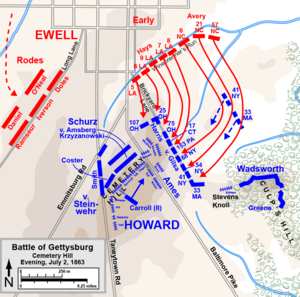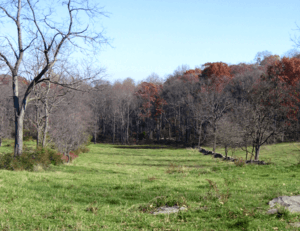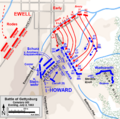Battle of East Cemetery Hill facts for kids
Quick facts for kids American Civil War |
|||||||
|---|---|---|---|---|---|---|---|
| Part of Ewell's demonstration, Battle of Gettysburg | |||||||
|
|||||||
| Belligerents | |||||||
| Confederate | Union | ||||||
| Commanders and leaders | |||||||
| Richard S. Ewell | Oliver O. Howard | ||||||
| Units involved | |||||||
| Louisiana Tigers Brigade | |||||||
| Casualties and losses | |||||||
| Heavy | |||||||
The Battle of East Cemetery Hill was an important fight during the American Civil War. It happened on the second day of the famous Battle of Gettysburg. Confederate soldiers, including the Louisiana Tigers Brigade, attacked a hill called East Cemetery Hill. But Union forces, led by Colonels Andrew L. Harris and Leopold von Gilsa, fought them off. This battle took place on the eastern side of Cemetery Hill, near the Baltimore Pike.
Confederate General Robert E. Lee wanted to distract the Union Army. He ordered Lt. Gen. Richard S. Ewell to make a "demonstration" (a fake attack) on the Union's right side. This was meant to keep Union soldiers busy while another big attack happened elsewhere. If Ewell's distraction worked well, he was allowed to turn it into a full attack.
Before the main infantry attack, Confederate cannons fired from Benner Hill around 4 p.m. Union soldiers on East Cemetery Hill were protected by special earthworks called "lunettes." These were like small forts. The Union cannons fired back, forcing Ewell's batteries to pull back. They suffered many losses, including Major Joseph W. Latimer.
Contents
The Fight Begins
Around 7 p.m., as the sun began to set, the Confederates attacked another nearby hill called Culp's Hill. At the same time, around 7:30 p.m., General Ewell sent two brigades from Jubal A. Early's division to attack East Cemetery Hill from the east. A "brigade" is a large group of soldiers. Ewell also told Maj. Gen. Robert E. Rodes to get ready to attack Cemetery Hill from the northwest.
The two brigades from Early's division were led by Brig. Gen. Harry T. Hays and Colonel Isaac E. Avery. They started their attack from a line near Winebrenner's Run, southeast of the town. Hays's group, the Louisiana Tigers, had about 1,200 men. Avery's group had three North Carolina regiments with about 900 men.
Union Defenses
The Union forces defending East Cemetery Hill were smaller. Colonel Harris's brigade had about 650 men. Colonel von Gilsa's brigade had about 500 men. Harris's soldiers were behind a low stone wall at the northern end of the hill. Some were also along Brickyard Lane (now Wainwright Avenue). Von Gilsa's men were spread out along the lane and on the hill itself.
Two Union regiments were placed in Culp's Meadow, expecting a different attack. Further west on the hill were other Union divisions. Colonel Charles S. Wainwright was in charge of the artillery (cannons) on the hill. The hill was quite steep, which made it hard for the cannons to aim low enough at the attacking infantry. However, they fired "canister shot," which was like a giant shotgun blast, to hit the Confederates.
Hand-to-Hand Combat
The Confederates attacked with a loud "Rebel yell." They charged toward the Union soldiers, finding gaps in the stone wall. Some Confederates even reached the cannons at the top of the hill. They fought hand-to-hand in the darkness with bayonets, musket butts, swords, pistols, and even rocks.
Brave North Carolina and Louisiana soldiers managed to clear the heights and silence some of the Union cannons. It was a fierce and close-quarters battle.
Union Reinforcements and Victory
As the Confederate attack started to slow down, Union reinforcements arrived. The 58th and 119th New York regiments came from West Cemetery Hill. A brigade led by Colonel Samuel S. Carroll also arrived from Cemetery Ridge. Carroll's men ran quickly through Evergreen Cemetery in the dark.
These fresh Union troops helped secure the cannons and pushed the North Carolinians back down the hill. The Louisiana attackers were also swept down the hill. Once they reached the bottom, the Union cannons fired canister shot at the retreating Confederates.
Brig. Gen. Dodson Ramseur, a Confederate commander, realized that a night attack against Union troops behind stone walls and supported by cannons was hopeless. Another Confederate general, James H. Lane, was supposed to help, but he didn't respond when asked. Both sides suffered many losses in this intense battle. Confederate Colonel Avery, for example, famously said, "Tell my father I died with my face to the enemy," showing his bravery.
Images for kids





